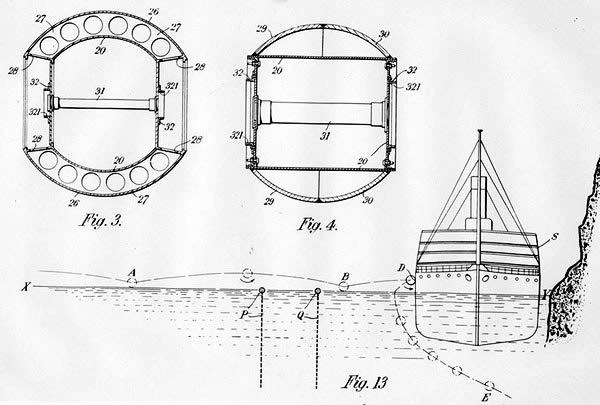Highball Footage, utterly fascinating stuff...
Discussion
I've seen some of this stuff before, but thetests over dry land are new to me
http://www.youtube.com/watch?v=8zBp1NCbAr0&fea...
http://www.youtube.com/watch?v=8zBp1NCbAr0&fea...
Strange how they appear to have forward spin (e.g. 2'35" in), I assumed all types of bouncing bomb would have had backspin, like the Upkeep version:

Image from Nationl Archives website http://www.nationalarchives.gov.uk/dambusters/idea...

Image from Nationl Archives website http://www.nationalarchives.gov.uk/dambusters/idea...
Eric Mc said:
Would the apparent forward spin be a strobing effect caused by the frame rate of the camera - like stagecoach wheels rotating backwards in a western film?
Yes, that's right. The first few bounces are with reducing check-spin. Then by the time it hits the wall, it is rolling forwards.
Very impressive accuracy. And totally nuts how close those observers were standing to the target line.
SpeckledJim said:
Eric Mc said:
Would the apparent forward spin be a strobing effect caused by the frame rate of the camera - like stagecoach wheels rotating backwards in a western film?
Yes, that's right. The first few bounces are with reducing check-spin. Then by the time it hits the wall, it is rolling forwards.
Very impressive accuracy. And totally nuts how close those observers were standing to the target line.
The idea of backspin on Upkeep was partly to keep it against the dam wall as it sank (or to go underneath a ship (Tirpitz?) as can be seen in the diagram I posted), so it would have to retain backwards spin right up to the end. The Highball in the test didn't seem to do this, hence my comment.
The MAIN reason why Wallis decided backspin was desirable was that it helped increase the relative speed between the surface of the weapon and the water at the point of contact. He wanted a higher contact speed than could be imparted if the bomb/mine had been dropped with no spin.
It was the need to maximise the speed at contact that pushed the Germans into trying to accelerate their version of the weapon using a rocket booster.
It was the need to maximise the speed at contact that pushed the Germans into trying to accelerate their version of the weapon using a rocket booster.
dr_gn said:
SpeckledJim said:
Eric Mc said:
Would the apparent forward spin be a strobing effect caused by the frame rate of the camera - like stagecoach wheels rotating backwards in a western film?
Yes, that's right. The first few bounces are with reducing check-spin. Then by the time it hits the wall, it is rolling forwards.
Very impressive accuracy. And totally nuts how close those observers were standing to the target line.
The idea of backspin on Upkeep was partly to keep it against the dam wall as it sank (or to go underneath a ship (Tirpitz?) as can be seen in the diagram I posted), so it would have to retain backwards spin right up to the end. The Highball in the test didn't seem to do this, hence my comment.
I think the difference is that in the land-based tests, the bomb bounced quite a few times against a higher-friction surface, and then was actually rolling before impact at or very near ground level.
On water, the bomb only bounced a few times before impacting above water-level, as obviously the bomb won't roll on water. Backspin was also useful to keep the bomb skipping on the water, rather than digging-in and sinking straight away. Gyroscopic precession will also have given it straight-line stability to help aiming.
Gassing Station | Boats, Planes & Trains | Top of Page | What's New | My Stuff



